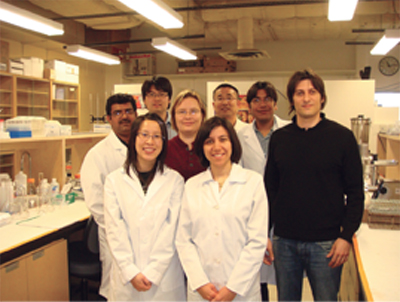
A New Film Star?
By The Poultry Research Centre University of Alberta
Features New Technology ProductionMechanically separated turkey meat never looked so good
At the recent University of Alberta Poultry Research Centre (PRC)
annual meeting, researcher Dr. Mirko Betti previewed a new, barely
visible product for the audience that is thinner than paper, opaque,
flexible – and entirely edible.
At the recent University of Alberta Poultry Research Centre (PRC) annual meeting, researcher Dr. Mirko Betti previewed a new, barely visible product for the audience that is thinner than paper, opaque, flexible – and entirely edible.
 |
|
| Edible Film from Low-value Meat Dr. Mirko Betti (far right) with the University of Alberta and his research team have developed an edible film from mechanically separated and other low-value poultry meat. Advertisement
|
Since his arrival in Edmonton in 2006, Dr. Betti has been working with his team at the PRC on a number of projects including protein recovery and new emerging technologies to improve poultry meat quality. He recently developed a process that appears to have very specific applications in the food industry. By taking mechanically separated poultry -and other “low-value” or underutilized poultry meat such as end-of-lay hens, broiler breeders, and even broiler dark meat, and applying a method to create a thin “film,” the possibilities for the industry stretch the imagination.
Low-cost product
The meat industry has a common challenge across all sectors – how can we get the most value from all parts of the carcass? Mechanically separated meat (MSM) is at one of the lower price points, and is a result of the last processing step on the line. By taking that low-cost product and processing it further, Dr. Betti’s team may be serving up a way to take that up a notch or two.
The use of animal proteins as “edible film” is not new. It began with animal intestines – pig, cow, and lamb – for sausage casings. Later, the potential uses expanded by processing collagen proteins, typically extracted from animal hides, into gelatin. The gelatin could be formed into films or capsules typically used in the pharmaceutical industry. There are some market segments, however, that may prefer to source from non-cow and non-pork sources, and poultry could be an alternative source.
At the moment, a disadvantage of animal proteins in edible film production is the natural hydrophilic nature of the proteins. These films tend to allow greater moisture loss as compared to either lipid-based or poly-based films (i.e., plastic food wrap). Possible solutions to adjust for this, says Betti, are just around the corner.
Consumer demand has renewed interest in the application of edible films to food products in the last 20 years. Consumers want high-quality foods, less packaging, and relatively inexpensive protein sources.
So, the protein film that Dr. Betti has been able to develop from turkey or chicken could be considered a “film” star. It is environmentally friendly, and it may allow for new products. Perhaps at different thicknesses, the film could act as a type of edible packaging.
Patent-pending
A patent application for the film is underway, and the researchers won’t divulge the details of how they created this elegant, filmy product from MSM. But Dr. Betti will say that the team “can process MSM in such a way that allows us to recover specific proteins and create this edible film.”
The film should be able to be applied to many different foods in order to lengthen the shelf life. The team’s next steps are to test various applications.
Working with Technology, Entrepreneur and Company Develop-ment (TEC) in Edmonton, Dr. Betti is assessing a commercialization strategy to take his team’s research to the marketplace. “Helping researchers and local inventors take their discoveries from the lab to the market is our goal,” says David Cox, CEO of TEC Edmonton. “There are many factors to consider when converting science to business and our team works alongside inventors to ensure that all angles are covered.”
For more information, contact Dr. Mirko Betti by e-mail at mirko.betti@ales.ualberta.ca or 780-248-1598).
Print this page